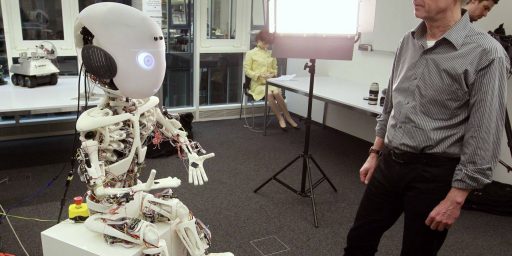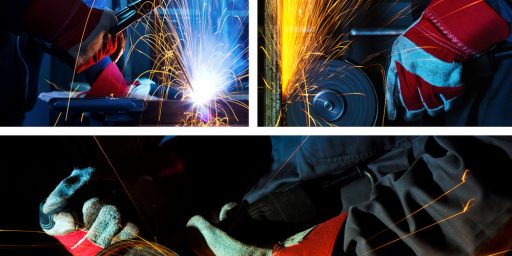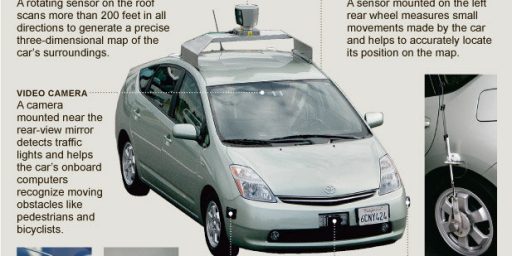Robot Soldiers Close to Battle Roll-Out
A New Model Army Soldier Rolls Closer to Battle
The American military is working on a new generation of soldiers, far different from the army it has. “They don’t get hungry,” said Gordon Johnson of the Joint Forces Command at the Pentagon. “They’re not afraid. They don’t forget their orders. They don’t care if the guy next to them has just been shot. Will they do a better job than humans? Yes.”
The robot soldier is coming.
The Pentagon predicts that robots will be a major fighting force in the American military in less than a decade, hunting and killing enemies in combat. Robots are a crucial part of the Army’s effort to rebuild itself as a 21st-century fighting force, and a $127 billion project called Future Combat Systems is the biggest military contract in American history.
The military plans to invest tens of billions of dollars in automated armed forces. The costs of that transformation will help drive the Defense Department’s budget up almost 20 percent, from a requested $419.3 billion for next year to $502.3 billion in 2010, excluding the costs of war. The annual costs of buying new weapons is scheduled to rise 52 percent, from $78 billion to $118.6 billion.
The entire history of science fiction notwithstanding, this is a logical extension of the long trend toward using machines to replace labor. From a military standpoint, this joins a long line of innovations ranging from shields to chain mail to suits of armor to tanks to unmanned aerial drones.
Stephen Green and Todd Pearson highlight this passage from the story:
“The lawyers tell me there are no prohibitions against robots making life-or-death decisions,” said Mr. Johnson, who leads robotics efforts at the Joint Forces Command research center in Suffolk, Va. “I have been asked what happens if the robot destroys a school bus rather than a tank parked nearby. We will not entrust a robot with that decision until we are confident they can make it.”
Trusting robots with potentially lethal decision-making may require a leap of faith in technology not everyone is ready to make. Bill Joy, a co-founder of Sun Microsystems, has worried aloud that 21st-century robotics and nanotechnology may become “so powerful that they can spawn whole new classes of accidents and abuses.” “As machines become more intelligent, people will let machines make more of their decisions for them,” Mr. Joy wrote recently in Wired magazine. “Eventually a stage may be reached at which the decisions necessary to keep the system running will be so complex that human beings will be incapable of making them intelligently. At that stage, the machines will be in effective control.”
Okay–so maybe we shouldn’t discount the lessons of science fiction entirely.






Holy Crap!!! I guess we as soldiers should just go throw ourselves off a cliff now; it appears that we are being replaced….
Bryan: No, we need you to fight the machines and keep them from buiding a time machine to go back and kill the leader of your resistance.
Let the damn machines kill each other off, I say.